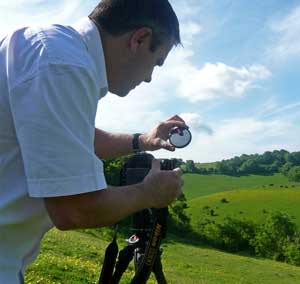If you only ever buy one filter, make it a polarising filter. Nigel Atherton explains why, and presents the options for polarising filters
If you only ever buy one filter, make it a polarising filter. Nigel Atherton explains why, and presents the options for polarising filters
Want to boost your colour saturation at a stroke, without going near a computer? Buy a polarising filter.
 Polarising filters work by suppressing reflections that occur on most surfaces. In the right conditions reflections on the surfaces of water and glass will vanish, allowing you to see more clearly through them.
Polarising filters work by suppressing reflections that occur on most surfaces. In the right conditions reflections on the surfaces of water and glass will vanish, allowing you to see more clearly through them.
But the contrast and colour saturation in your photos dramatically improves too. Blue skies become bluer, clouds stand out more, trees and grass look greener, and all the other colours in your scene seem richer. The transformation happens instantly, before your eyes, and cannot be replicated on a PC.
Polarising filters work best on sunny days with the sun at an angle of about 90° to the subject. On grey, overcast days they may have little or no effect.
Types of polarising filter
 There are two types of polarising filter: linear and circular. This isn’t a reference to the shape of the filter itself – most are round – but to the way in which they polarise the light. For digital cameras you need the (sadly more expensive) circular type.
There are two types of polarising filter: linear and circular. This isn’t a reference to the shape of the filter itself – most are round – but to the way in which they polarise the light. For digital cameras you need the (sadly more expensive) circular type.
Make up of polarising filters
Most polarising filters are comprised of two connected rings that rotate independently of each other. Once you’ve screwed it onto the lens, the front part is rotated until you get the polarising effect you want.
You can also get polarisers that slot into filter holders such as those from Cokin and rotate within the holder. Whichever kind you get, they all reduce the light entering the lens by about 1.5 to 2 stops, so you’ll have to compensate accordingly.
Choosing a polarising filter
When choosing a polarising filter you’ll find a wide disparity of prices, even within the same brand. Hoya, for example, sells a 67mm polariser for under £50, and another for over £100.
What you’re paying for is superior optical glass, anti-reflective coatings, and perhaps superior engineering in the mount. Some boast a thinner profile so they’re less likely to cause vignetting when used with wideangle lenses.
Whether these things are worth the extra cost to you is a personal choice. If you use premium quality zoom or prime lenses (such as Canon’s L series optics) it’s probably worth investing in the best polarising filters to go with them; otherwise as long as you stick to one of the main brands listed here, you’re unlikely to be disappointed.
Polarising Filter – Top Brands
A guide to the main polarising filters to consider
B+W
The German flair for making top quality optical glass exceeds even their penalty-taking prowess. Made by Schneider, B+W filters aren’t cheap, but feel the weight of that Schott glass (made by Zeiss) and those hefty brass mounts and know you’re getting a quality product. Choose from its basic polariser, its MRC multi-coated filter or its premium Kasemann range, in which the filters are polished plane-parallel and sealed against moisture ingress.
Hoya
The world’s largest filter manufacturer recommends its Pro 1 Digital series for DSLR users. They feature low-profile, matte black frames housing optical glass which is multi-coated to reduce flare and reflections. There’s also a more basic polariser for about half the price.
Lee
Beloved of pro landscape photographers everywhere, most Lee filters are hand-made from optical resin and are designed around Lee’s 100mm filter holder. Lee produces two polarisers to fit it: a square 100x100mm filter and a round 105mm diameter one. Lee also produces a clip-on polariser for its smaller 75mm system.
Heliopan
The Heliopan range is very similar to the B+W range: made in Germany using Schott glass, brass mounts and with a Kasemann variant. However, Heliopan filters, which have traditionally been aimed more at the movie industry, are somewhat cheaper.
Cokin
Cokin’s circular polariser is actually circular. It fits into the rear slot of its holder and can be rotated within it. There are four sizes, to fit the A, P, X and Z series holders.
Tiffen
Better known in the US than the UK, Tiffen has been making filters for 60 years, and they are widely used in Hollywood. Tiffen’s patented ColorCore technology involves laminating the filter material between sheets of optical glass.
Sigma
The biggest name in independent lenses also produces an EX DG circular polariser. It features a multi-layer coating and a low-profile mount to reduce vignetting. The range extends from 52mm to 105mm.
Other brands to consider:
- Jessops
- Kood
- Formatt






